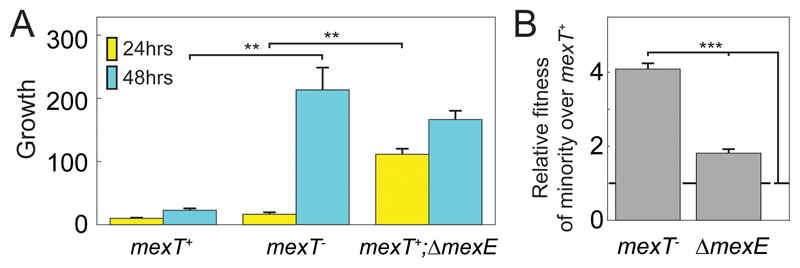Figure 3.
Growth (A) and selection in co-culture (B) of different mex variants. (A) Growth after 24 and 48 hours of the efflux inactive strains mexT-;mexE+, mexT+;ΔmexE and the efflux active mexT+;mexE+ strain. Growth is defined as in Figs. 1A,B. Averages and standard errors are calculated for multiple repeats performed on three separate days. (B) The strains mexT-;mexE+ (PT5) and mexT+;ΔmexE (PT637) were separately co-cultured as minorities with the efflux active strain mexT+;mexE+ (PT149). Shown is the relative fitness of each minority strain over the majority strain. Relative fitness is calculated by dividing the relative frequency of two co-cultured strains at the end of growth (after 48 hours) by their relative initial frequency in the co-culture. A value of 1 indicates no fitness advantage. Initial frequency of the efflux inactive strains was set to ~5%. Co-cultured strains coded for a GFP and BFP constitutive reporters. Results are the summary of 18 co-culture experiments for each co-cultured pair, in half of the repeats the BFP was expressed in the majority strain and in half it was expressed in the minority strain. In A,B Error bars represent the standard error of the mean. ** p-value<10-3, *** p-value<10-6. In B, significance is also with respect to deviation from a value of one (no fitness difference).

